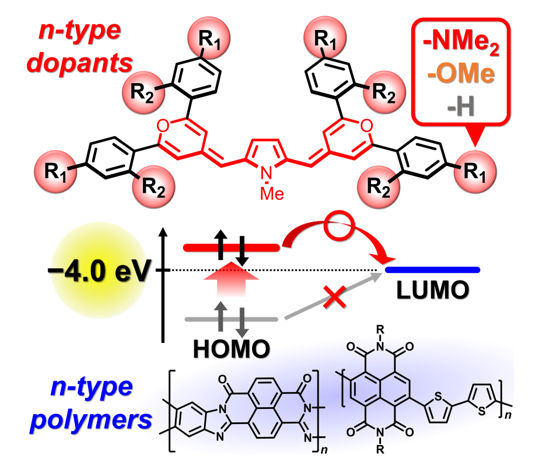Organic thermoelectrics that converts waste heat into electricity using organic semiconductors have been expected to contribute to solve the energy and environmental issues, and the development of superior material is one of the kyes for the advance organic thermoelctrics in future. Highly efficient thermoelectric conversion requires both p- and n-type semiconductor materials with holes and electron as carriers, respectively. Also, it is important to control the carrier density in the semiconductors for maximizing the thermoelectric performances. Organic radical precursors are generally used for electron doping in n-type organic semiconductors. However, as the diversity of materials is quite limited, the development of not only new materials but also new design guidelines for efficient electron dopants are highly awaited.
In this research, we aimed to develop a new electron-dopants by adjusting the electronic structure based on the closed-shell organic molecules. For this purpose, we chose a closed-shell molecular framework with a high-lying energy level of the highest occupied molecular orbital (HOMO) and then introduce electron-donating groups. The theoretical calculations predicts that the target molecules (upper figure) have extremely high-lying HOMO, and we synthesized these molecules. The evaluation of their HOMO energy levels by the electrochemical method and the Kelvin probe method in a nitrogen atmosphere demonstrated that the HOMO levels were higher than 4 eV from the vacuum level, which is among the highest for closed-shell organic molecules.
BBL and N-2200 (bottom of the figure), well-known n-type semiconductor polymers, were used as host materials, and the electron-doping by the newly developed dopants gave the electron-doped polymer materials that show better thermoelectric performances than those of the corresponding polymers doped by N-DMBI, which is the commonly used electron dopant in the organic thermoelectric research.
These results show that efficient n-type doping can be realized even with molecules with a closed-shell electronic structure. More importantly, molecular design for electron dopants is more versatile and flexible than so far believed, and various molecular skeletons with electron donating properties could be candidate platforms for excellent n-type dopants for organic thermoelectric applications.

